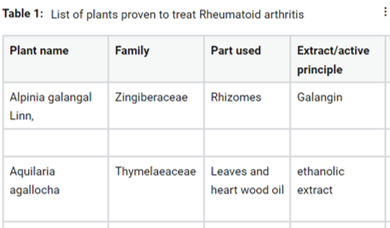Abstract
Rheumatoid arthritis is most significant and devastating to the human body. It is an autoimmune disorder that affects almost 2-4% of the population of the world. Rheumatoid arthritis usually occurs when the immune system works against one’s own body and attacks it. Rheumatoid arthritis generally affects the joints like wrists, elbows, knees and ankles. Even though the reason for causing RA is unknown, the contributing factors for the development of the RA are of various types. Usually women are more affected by RA then men due to the prevalence of hormonal changes. Age is also an important factor that contributes for the development of RA. The general treatment approach for rheumatoid arthritis is to prevent further damage of joints and lower the inflammation and pain. Symptomatic treatment is also the base for RA treatment in many patients. Considering these side effects and limited use of the synthetic drugs, a deep focus has been put into herbal drugs as useful remedies to treat RA successfully. So there has been as growing trend towards development of polyherbal formulation employing potent herbs to treat the disease. Scientific investigations had been carried out to prove the potency of the herbs to treat RA in various animal and invitro models. Many polyherbal formulations had been marketed successfully and were prescribed by the physician. In this view the standardization stands as utmost important parameter for proving the quality of the formulation. Considering the marketed formulations attempts are to be made to determine the quality and effect of the herbal formulations. Investigations are also to be made to determine the interaction between the herbs employed in the formulation.
Full text article
References
Chandrasekar, R., Chandrasekar, S. 2017. Natural herbal treatment for rheumatoid arthritis-a review. International Journal of Pharmaceutical Sciences and Research, 8(2):368–384.
Deighton, C., O’Mahony, R., et al. 2009. Management of rheumatoid arthritis: summary of NICE guidance. BMJ, 338(mar16 1):b702–b702.
Firestein, G. S., McInnes, I. B. 2017. Immunopathogenesis of Rheumatoid Arthritis. Immunity, 46(2):183–196.
Kadhim, M. J., Kaizal, A. F., Hameed, I. H. 2016. Medicinal plants used for treatment of rheumatoid arthritis: A review. International Journal of Pharmaceutical and Clinical Research, 8(12):1685– 1694.
Kobelt, G. 2009. The social and economic impact of rheumatoid arthritis. Rheumatoid Arthritis, pages 83–89.
Petchi, R. R., Parasuraman, S. 2015. Antiarthritic activity of a polyherbal formulation against Freund′s complete adjuvant induced arthritis in Female Wistar rats. Journal of Basic and Clinical Pharmacy, 6(3):77–77.
Saag, K. G., Teng, G. G., et al. 2008. American College of Rheumatology 2008 recommendations for the use of nonbiologic and biologic disease modifying antirheumatic drugs in rheumatoid arthritis. Arthritis & Rheumatism, 59(6):762–784.
Sara, B. B., Sailaja, A. K. 2019. A Review on Polyherbal Formulations used in the Treatment of Autoimmune Disease like Rheumatoid Arthritis. Research & Reviews: Journal of Herbal Science, 8(1):11–16.
Singh, S., Nair, V., Gupta, Y. K. 2011. Antiarthritic activity of majoon suranjan (a polyherbal Unani formulation) in rat. The Indian Journal of Medical Research, 134:384–388.
Authors

This work is licensed under a Creative Commons Attribution-NonCommercial-NoDerivatives 4.0 International License.

